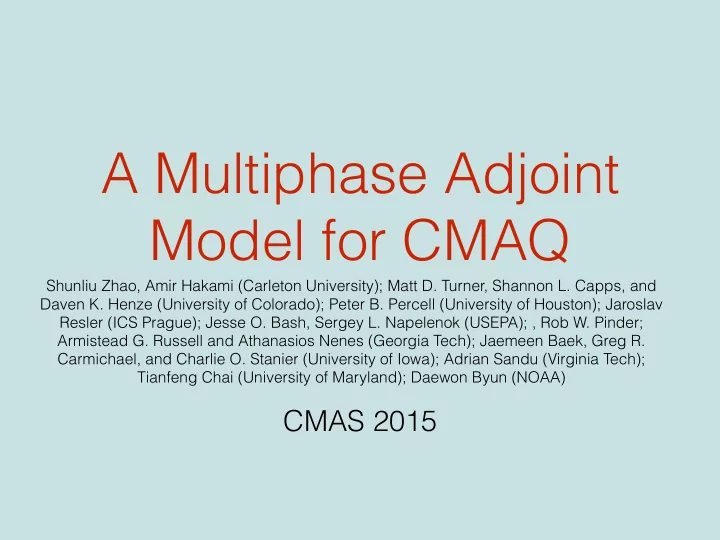

A Multiphase Adjoint Model for CMAQ Shunliu Zhao, Amir Hakami (Carleton University); Matt D. Turner, Shannon L. Capps, and Daven K. Henze (University of Colorado); Peter B. Percell (University of Houston); Jaroslav Resler (ICS Prague); Jesse O. Bash, Sergey L. Napelenok (USEPA); , Rob W. Pinder; Armistead G. Russell and Athanasios Nenes (Georgia Tech); Jaemeen Baek, Greg R. Carmichael, and Charlie O. Stanier (University of Iowa); Adrian Sandu (Virginia Tech); Tianfeng Chai (University of Maryland); Daewon Byun (NOAA) CMAS 2015
Outline • Motivation for developing a multiphase adjoint model • The current status of the development • Adjoint code • Process-by-process validation • Test run of the full adjoint model • Concluding remarks
Motivation • CMAQ: Evolution of atmospheric gas and aerosol species • Forward sensitivity analysis (Decoupled Direct Method, DDM) source receptor Forward Backward • Backward/Adjoint sensitivity analysis
Adjoint sensitivity analysis: An example Pappin et al., “Compounding Benefits of Air Pollution Control: A Revised View of Air Pollution Economics”, Wednesday Presentation
The current status of the adjoint development • CMAQ scientific processes: chemistry, aerosol, transport, cloud • Adjoint code generated by tools (KPP, Tapenade, TAMC) or by hand • Code validating using • Finite Difference Method (FDM) • Complex Variable Method (CVM) • and sometimes DDM/TLM
Process-by-process validation Process Sub-processes Validation Methods Finite difference Chemistry Complex variable Secondary organic aerosol, Heterogeneous chemistry, Coagulation, Nucleation, Finite difference Aerosol Condensation, Thermodynamics (Isorropia; Complex variable Capps et al., 2012) Horizontal/vertical advection, Horizontal/ Transport Finite difference vertical diffusion Finite difference Convective cloud, Resolved cloud, Aqueous Cloud Complex variable chemistry Tangent linear model
Process-by-process validation Process Sub-processes Validation Methods Finite difference Chemistry Complex variable Secondary organic aerosol, Heterogeneous chemistry, Coagulation, Nucleation, Finite difference Aerosol Condensation, Thermodynamics (Isorropia; Complex variable Capps et al., 2012) Horizontal/vertical advection, Horizontal/ Transport Finite difference vertical diffusion Finite difference Convective cloud, Resolved cloud, Aqueous Cloud Complex variable chemistry Tangent linear model
Th adjoint of chemistry: Limitations of the FDM Adjoint Finite difference
The adjoint of chemistry Adjoint Complex variable
The adjoint of chemistry: Full Jacobian Adjoint Complex variable
Process-by-process validation Process Sub-processes Validation Methods Finite difference Chemistry Complex variable Secondary organic aerosol, Heterogeneous chemistry, Coagulation, Nucleation, Finite difference Aerosol Condensation, Thermodynamics (Isorropia; Complex variable Capps et al., 2012) Horizontal/vertical advection, Horizontal/ Transport Finite difference vertical diffusion Finite difference Convective cloud, Resolved cloud, Aqueous Cloud Complex variable chemistry Tangent linear model
The adjoint of aerosol: secondary organic aerosol Complex variable Adjoint
The adjoint of aerosol: heterogeneous chemistry
The adjoint of aerosol: coagulation
The adjoint of aerosol dynamics Adjoint Complex variable
The adjoint of aerosol: Isorropia
The adjoint of aerosol: aerosol dynamics and thermodynamics Adjoint Finite difference
The adjoint of aerosol: aerosol dynamics and thermodynamics Adjoint Finite difference
Process-by-process validation Process Sub-processes Validation Methods Finite difference Chemistry Complex variable Secondary organic aerosol, Heterogeneous chemistry, Coagulation, Nucleation, Finite difference Aerosol Condensation, Thermodynamics (Isorropia; Complex variable Capps et al., 2012) Horizontal/vertical advection, Horizontal/ Transport Finite difference vertical diffusion Finite difference Convective cloud, Resolved cloud, Aqueous Cloud Complex variable chemistry Tangent linear model
The adjoint of transport: horizontal advection • Horizontal advection at the X direction / discrete adjoint Adjoint Finite Difference
The adjoint of transport: vertical diffusion Adjoint Finite Difference
The adjoint of vertical diffusion and chemistry Adjoint 0.1 ppbV 1 ppbV 10 ppbV Finite Difference
Process-by-process validation Process Sub-processes Validation Methods Finite difference Chemistry Complex variable Secondary organic aerosol, Heterogeneous chemistry, Coagulation, Nucleation, Finite difference Aerosol Condensation, Thermodynamics (Isorropia; Complex variable Capps et al., 2012) Horizontal/vertical advection, Horizontal/vertical Transport Finite difference diffusion Finite difference Convective cloud, Resolved cloud, Aqueous Cloud Complex variable chemistry Tangent linear model
The adjoint of clouds • Aqueous chemistry (KPP; Kathleen Fahey, EPA) Adjoint DDM
Test run of the full adjoint model Day 1 Day 4
Test run of the full adjoint model Day 1 Day 4 without AQCHEM
Lessons learned Automatic differentiation entails a number of problems • • Significant clean-up debugging is necessary • Single/double precision • Active variables passed by modules not visible to some top routines • Uninitialized variables in the adjoint code Problems that can be ignored in process-by-process • tests may become more serious in interaction with other processes A number of issue can be avoided if forward model • development is mindful of differentiation • Fractured response surface for a number of processes
Concluding remarks • When testing with the full adjoint model, blow-ups in the adjoint sensitivities caused by various reasons have been observed. Despite numerous bug fixes, large numbers still exist. • Process-by-process validations are positive in general. But there seems to be interactions between processes which cause the abnormal growth in sensitivities.
Acknowledgements Funding: • API, NSERC • Model support: • USEPA •
Recommend
More recommend